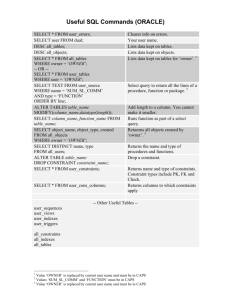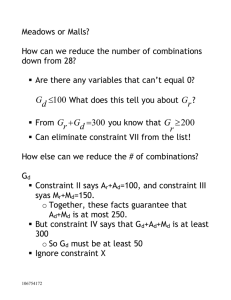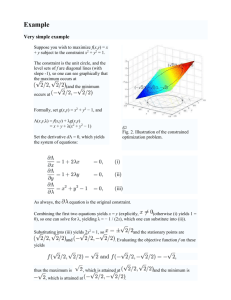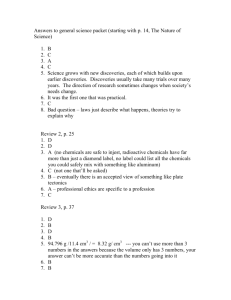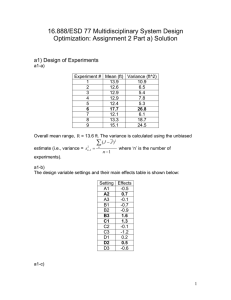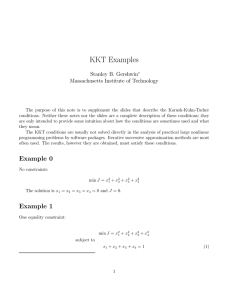ee 572 optimization theory
advertisement
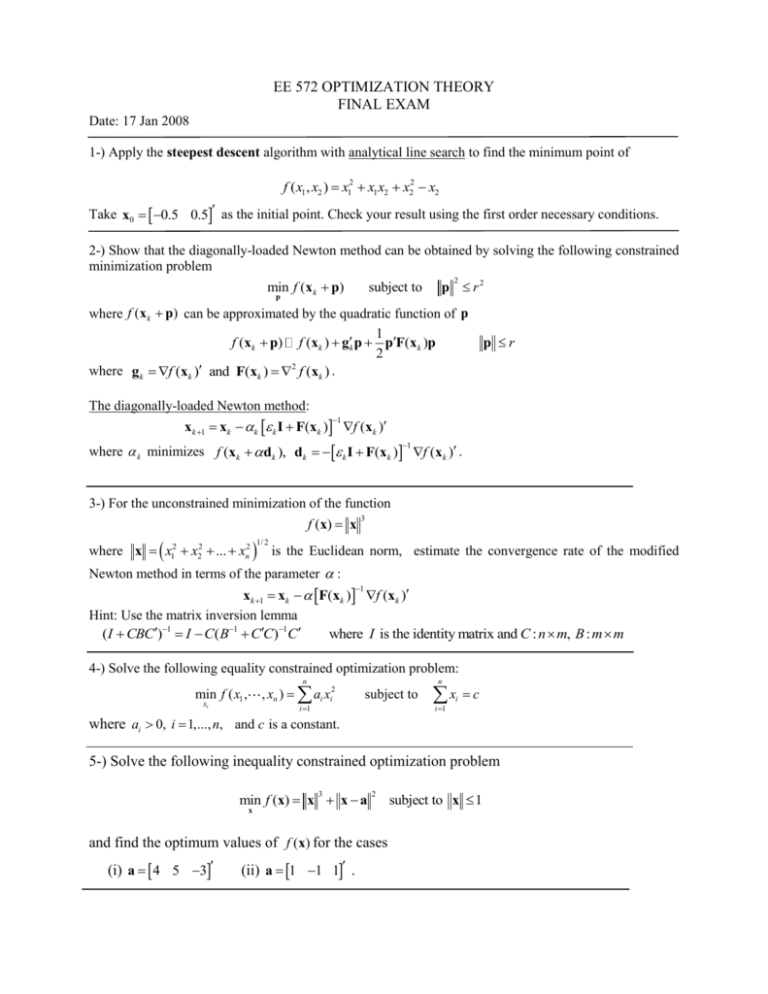
EE 572 OPTIMIZATION THEORY FINAL EXAM Date: 17 Jan 2008 1-) Apply the steepest descent algorithm with analytical line search to find the minimum point of f ( x1 , x2 ) x12 x1 x2 x22 x2 Take x0 0.5 0.5 as the initial point. Check your result using the first order necessary conditions. 2-) Show that the diagonally-loaded Newton method can be obtained by solving the following constrained minimization problem min f (xk p) subject to p p r2 2 where f (x k p) can be approximated by the quadratic function of p 1 f (xk p) f (xk ) gk p pF(xk )p 2 where gk f (xk ) and F(xk ) 2 f (xk ) . p r The diagonally-loaded Newton method: xk 1 xk k k I F(xk ) f (xk ) 1 where k minimizes f (xk dk ), dk k I F(xk ) f (xk ) . 1 3-) For the unconstrained minimization of the function f (x) x where x x12 x22 ... xn2 1/ 2 3 is the Euclidean norm, estimate the convergence rate of the modified Newton method in terms of the parameter : xk 1 xk F(xk ) f (xk ) Hint: Use the matrix inversion lemma ( I CBC)1 I C(B1 CC)1 C where I is the identity matrix and C : n m, B : m m 1 4-) Solve the following equality constrained optimization problem: n , xn ) ai xi2 min f ( x1 , xi n subject to i 1 x i 1 i c where ai 0, i 1,..., n, and c is a constant. 5-) Solve the following inequality constrained optimization problem min f (x) x x a 3 2 x and find the optimum values of f (x) for the cases (i) a 4 5 3 (ii) a 1 1 1 . subject to x 1 SOLUTION 1-) Steepest descent: x k 1 x k k g k where k minimizes f (x k g k ). g f ( x) 2 x1 x2 x 0 [0.5 0.5] g 0 =[ 0.5 0.5] f (x 0 g 0 ) 0.25(3 2 2 1) x1 2 x2 1 x1 = -1/3 2/3 0.5 0.5 x0 g 0 = 0.5 0.5 f ( ) 0 0 1/ 3 f ( x1 ) 0 x* = x1 2-) The KKT conditions: p f (x k p ) k p g c (p ) 0 g c (p) p r 2 2 k ( p r 2 ) 0 2 k 0 g k F (x k )p 2k p 0 p F (x k ) k I g k 1 Assume that the constraint is active p r, where k 2k k > 0 p pp gk F (x k ) k I g k r 2 0 2 2 k > 0 is such that F (x k ) k I is positive definite. x k 1 x k p x k F (x k ) k I g k 1 If the constraint is inactive, k = 0 p F (x k ) g k 1 may not exist if F (x k ) is singular. 3-) f (x) x x12 xn2 3 f 3 2 x1 xi 2 3/ 2 f f ( x ) x1 xn2 .2 xi 3 x .xi 1/ 2 f x2 f (x) 3 x . x1 x xi xi2 2 f 3 x 3 x 3 x 3 x 3 x i i xi2 xi x x xj 2 f 3xi i j x j xi x xx xx F ( x) 3 x I 3 x I 2 x x f xn x2 xn 3 x .x Modified Newton method: x k 1 x k F(x k ) f (x k ) 1 Using the matrix inversion lemma, F(x k ) 1 x x I k k2 2 x k 1 3 xk x x x ( x x ) 1 I k k 2 .3 x k .x k x k k k 2k x k 2 2 x k 2 xk 1 1 x k 1 x k x k 1 x k 0 2 2 2 x k 1 1 1 Convergence rate, 1 linear with rate 1 . xk 2 2 F(x k ) 1 f ( x k ) 1 3 xk 4-) Lagrangian: n where h(x) xi c l ( x, ) f ( x ) h ( x ) i 1 x l ( x, ) 0, Necessary conditions f ( x ) h ( x ) 0 h(x) 0 f f ( x ) x1 h(x) 1 1 (1) l ( x, ) 0 2a j x j 0 Constraint equation (2) 1 n i 1 xj 1 aj c n 1 a i 1 i f 2a1 x1 xn f x2 j 1, (1) (2) ,n 1 c 2ai xj 2a2 x2 2a j 2c 1 i 1 ai n 2an xn 5-) f ( x) x x a 3 2 g (x) x 1 xx 1 2 KKT conditions: f (x) g (x) 0 g (x) 0, 0 f (x) 3 x x 2(x a) g ( x ) 2 x 3 x x 2(x a) 2x 0 (1) ( x 1) 0, 0 2 x 2a 5 2 0 Suppose constraint is inactive x 2 x 3 x = 2 a 2a 5 2 1 2 a 5 2 3 x x 2x 2a x 2a 23 x Constraint equation 2 This solution is feasible if x a 2.5 0 2a 23 x (5 2 )x 2a Constraint This solution is feasible if x 1 3x 2 x 2x 2a (1) 0 Suppose constraint is active 2 x 3 x 5 2 a 2.5 The optimum solution is found by solving the quadratic equation above for x when a is given. (i) a 4 5 3 a 50 3 Constraint is active. a 1 4 5 3 a 50 x* 2 2 a f (x ) 1 a 1 a 1 37.8578 a * (ii) a 1 1 1 a 33 2 x 3 x = 2 3 2 Constraint is inactive. Let r x The positive solution of this equation is r 0.79175 2 f (x* ) 0.4963 x* a =1.38046 3r 2 2 r 2 3 0 x* 2a 0.45712a 2 3 x*





